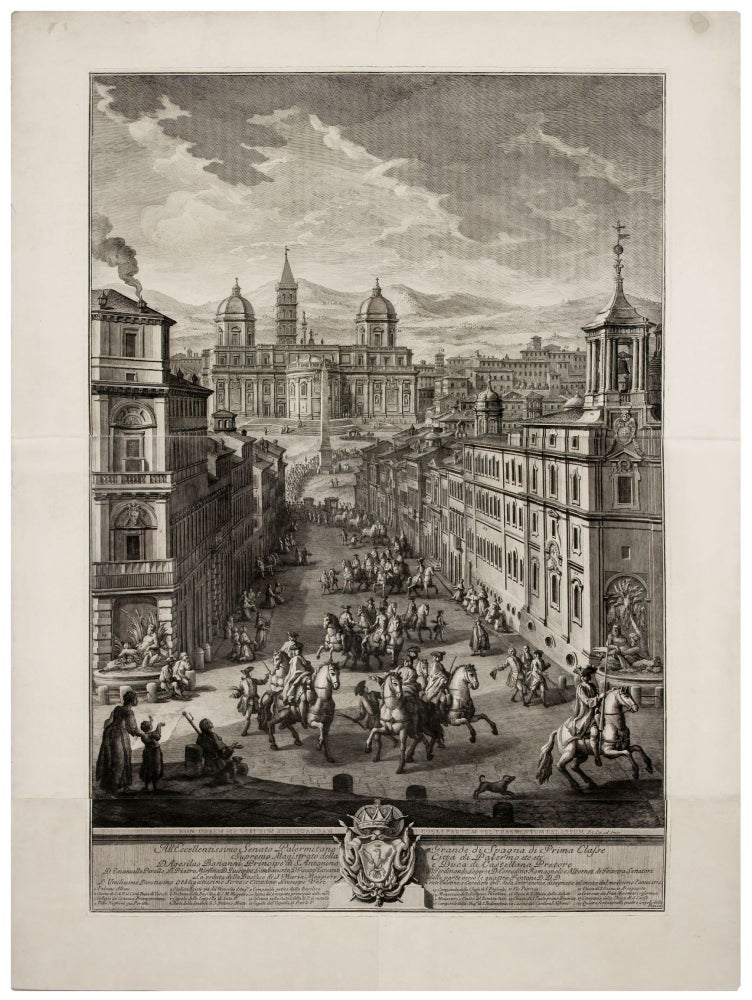
Non urbem me visurum … All'Eccellentissimo Senato Palermitano Grande di Spagna … D. Agesilao Bonanni … La Veduta della Basilica di S. Maria Maggiore dalla parte verso le quattro Fontane … Giuseppe Vasi Conte Palatino, e Cavaliere dell'Aula Lateranense, disegnata ed incisa dal medesimo, l'anno 1771.
Three-sheet etching [101.5 x 68.8 cm the platemark]. Wide margins, a few repaired marginal tears, bottom blank margin replaced; verso backed. Printed surface rich in tone. Rare, large-format, separately issued etching on three-sheets by Giuseppe Vasi (1710-82) depicting the Basilica of Santa Maria Maggiore in Rome as seen from the Quattro Fontane. The work is one of four large vedute etchings – two published in 1765 and two in 1771 – incorporating the four patriarchal basilicas of Rome into sweeping vistas seen from some of the city’s most celebrated vantage points. Vasi seems to have designed these etchings to be displayed either on their own or in conjunction with his iconic 18-sheet Prospetto dell’Alma città di Roma (1765), a breathtaking panorama of the city unsurpassed in its ambition: “Vasi’s large prints of the four patriarchal basilicas were issued with exactly the same vertical dimensions as the Prospetto in order to grant uniformity to and enhance the aesthetics of collective display. In Vasi’s scheme, then, any single work could stand alone, or be enriched through association with related material” (Maier, p. 219), a feature typical to European décor in the second half of the 18th century (and which provided Vasi with commercial flexibility in marketing his prints). The etching, dedicated to the Grande di Spagna Agesilao Bonanni, shows the Piazza Quattro Fontane in the foreground, with two of the four fountains (depicting the Tiber and Aniene) installed there by Domenico Fontana between 1588 and 1593 visible. A long procession of horsemen snakes up the Via delle Quattro Fontane from the apse end of Sta. Maria Maggiore half a mile away. The Alban Hills are seen in the distance. A key at the foot of the etching names 24 features of the print, including architectural elements of the basilica, the Esquiline obelisk, the Esquiline column, and the campanile of the church of Sta. Prassede; the flank of Borromini’s San Carlo alle Quattro Fontane is visible at the right foreground. “A native of Corleone, Sicily, Vasi had arrived in Rome in 1736, where he became known for his vedute catering to Grand Tourists’ insatiable desire for souvenirs of the Eternal City. Like Falda in the previous century, Vasi specialized in relatively unembellished interpretations of Rome’s settings and architecture that situated monuments in their urban context. In this regard he distinguished himself from his competitor Giovanni Battista Piranesi, whose vedute offered a more romantic vision of Rome’s monuments, and often isolated them for dramatic effect” (Maier, p. 218). Vasi’s reputation today rests on his role as the engraver for Nolli’s influential pianta grande, on his Prospetto, and on his 10-book Magnificenze di Roma antica e moderna (1747-61), a commemorative set of Roman architectural views arranged by building type. OCLC locates no U. S. examples of this etching.
Price: $3,850.00
